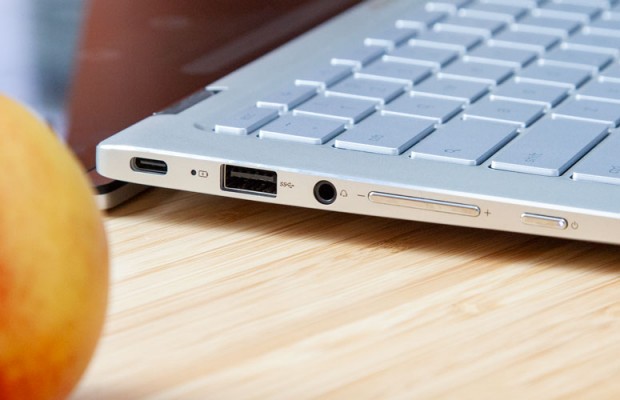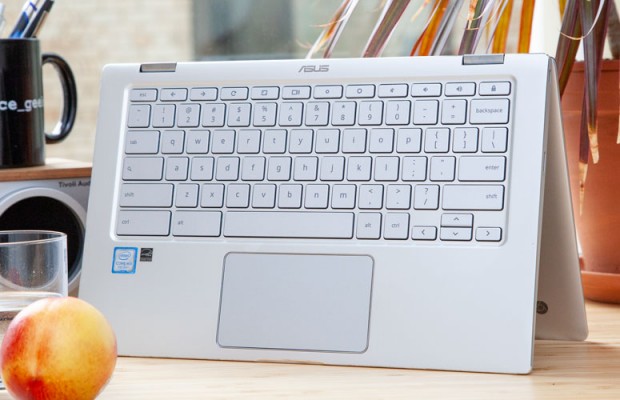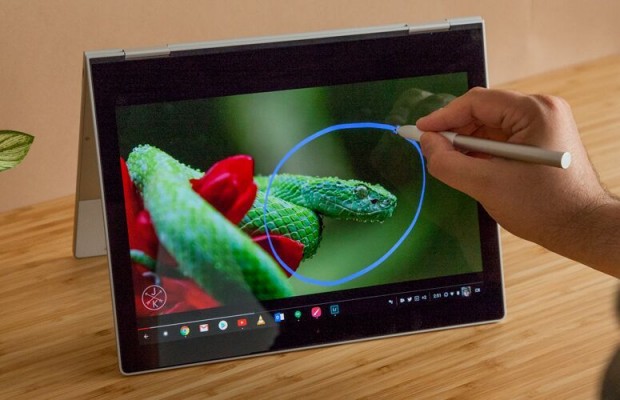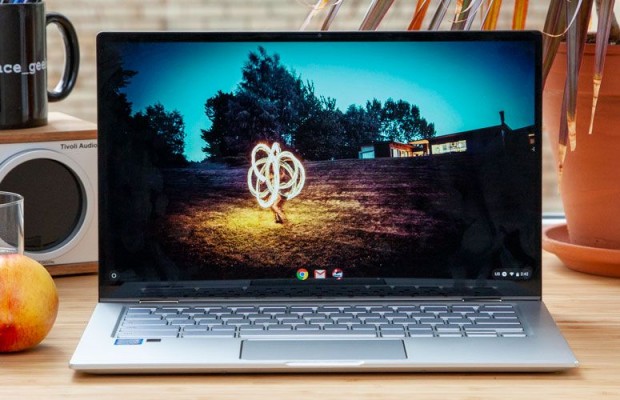Google Pixelbook vs. Asus Chromebook Flip C434: Face-Off!
The Asus Chromebook Flip C434 is the undefeated best Chromebook title holder after KO'ing the HP Chromebook x360 14 G1 and the Asus Chromebook Flip C302. The 14-inch convertible has a sleek aluminum chassis, slim bezels and a vivid display. Add in long battery life and solid performance, and the Flip C434 ticks all the right boxes.
But if any laptop is capable of knocking the Flip C434 off its perch, it's the Google Pixelbook. The first premium Chromebook worth buying, the Pixelbook has a breathtaking design and outstanding performance. As much praise as we've given Asus' new Chromebook Flip C434, is it really as good as Google's own Pixelbook? Read our in-depth comparison to find out.
Google Pixelbook vs. Asus Chromebook Flip C434: Specs compared
| Row 0 - Cell 0 | Google Pixelbook | Asus Chromebook Flip C434 |
| Starting Price (as configured) | $999 ($1,199) | $569 |
| Colors | Silver/White | Silver Spangle |
| Display | 12.3-inch, 2400 x 1600-pixel (touch) | 14 inches, 1080p (touch) |
| CPU | Intel Core i5-7Y57 | Intel Core m3-8100Y |
| RAM | 8GB | 4GB |
| SSD | 256GB | 64GB |
| Key Travel | 0.9mm | 1.3mm |
| Ports | Two USB-C, headphone | USB 3.1 (Type-A), two USB Type-C, microSD, headphone |
| Webcam | 720p | 720p |
| Size | 11.6 x 8.7 x 0.4 inches | 12.6 x 8 x 0.6 inches |
| Geekbench 4 | 7,927 | 6,986 |
| Battery Life (hrs:mins) | 7:43 | 9:58 |
| Weight | 2.5 pounds | 3.1 pounds |
Design
The Pixelbook has a unique appearance for a couple of reasons. For one, the lid mixes silver aluminum and white glass, much like Google's Pixel smartphones. On the bottom is more aluminum, except, at this location, it connects with a white rubber pad.
The other standout design element of the Pixelbook is the laptop's flat stance. Unlike most laptops, the Pixelbook's base is the same width as the lid, which gives the laptop a flat, straight appearance.I personally love the effect and wish more laptops echoed this design.
Sign up to receive The Snapshot, a free special dispatch from Laptop Mag, in your inbox.
While modern, the Chromebook Flip C434's design looks ordinary by comparison. The chassis is made of matte-silver aluminum, while chrome hinges, branding and trim add some elegance to the exterior.
The Pixelbook may be the sexier laptop from the outside, but the Flip C434 outshines Google's Chromebook once you open these laptops' lids. Chunky black bezels make the Pixelbook look as if it came from a different era, whereas the Asus has a modern appearance, thanks to the razor-thin frames around its display.
MORE: Lenovo Yoga Chromebook C630 vs. Google Pixelbook
That design element alone gives the Flip C434 the edge over the Pixelbook. Not only do the bezels provide a more captivating viewing experience, but they also keep the Flip C434's chassis very compact. At 0.6 inches thick and 3.1 pounds, the Chromebook Flip C434 isn't much larger or heavier than the 0.4-inch, 2.5-pound Pixelbook, despite a significantly larger display.
Both laptops are convertibles, which means you can flip their displays back into tent or tablet mode. Because of its thinner chassis, the Pixelbook makes for a more comfortable tablet.
Winner: Chromebook Flip C434
Buy Asus Chromebook Flip C434 on Amazon.com
Ports
The Chromebook Flip C434 offers a wider range of ports than the Pixelbook. On the left side of the Flip C434 is a USB 3.1 Type-A port, a USB-C port and a headphone jack, while the opposite side houses a second USB-C port and a microSD card reader.
The Pixelbook earns points for also having USB-C charging ports on each side, but the only other connection on this superslim laptop is a headphone jack.
Winner: Chromebook Flip C434
Buy Google Pixelbook on Amazon.com
Display
For the price, it's hard to fault the Chromebook Flip C434's 14-inch, 1080p touch screen. But the Pixelbook's 12.3-inch, 2400 x 1600-pixel touch panel is sharper, more colorful and brighter.
The upcoming Sonic the Hedgehog movie looked visually great on both laptop displays, though the beloved video-game character's deep blue fur popped more on the Pixelbook. Not only were the colors more vivid on the Pixelbook, but the screen was also brighter under the dim lights in our office. The Pixelbook really pulled ahead after I visited a website and noticed that the white balance on the Flip C434 looked yellow when compared side by side with the clean white on the Google laptop.
The Pixelbook also has a higher pixel density, though strands of hair on Sonic's head looked only a bit sharper on the Chromebook. On the other hand, the Chromebook Flip C434's larger display offered a more immersive viewing experience. Note, the Flip C434 has a standard 16:9 aspect ratio, while the Pixelbook's is 3:2.
I had no problems using touch gestures on either convertible laptop to switch between tabs and press on links.
Although the Chromebook Flip C434 put up respectable benchmark numbers, the Pixelbook crushed the Asus in every display category. According to our colorimeter, the Pixelbook covers 117% of the sRGB color gamut, while the panel on the Chromebook Flip C434 reached 93%. Both laptops exceed the Chromebook category average of 81%.
MORE: Best 2-in-1 Laptops
As expected, the Pixelbook registered a higher brightness rating. Peaking at 421 nits of brightness, the Pixelbook outshined the Flip C434 by a wide margin (286 pixels). Again, both of these Chromebooks topped the category average (234 nits).
Winner: Pixelbook
Keyboard and Touchpad
The keyboards on these laptops are both decent, but I prefer the one on the Flip C434, if only by a hair.
The silver backlit keys on the Chromebook Flip C434 are properly spaced and appropriately sized no matter how large or small your hands are. They are on the shallow side, with just 1.3 millimeters of travel (1.5mm is our minimum preference), but an actuation force of 71 grams gives the keys a weighty feel.
The Pixelbook's keys are even more shallow, sinking a measly 0.9mm into the deck. Fortunately, the keyboard has a comfortable layout, and the keys' 68 grams of actuation force gives them a more satisfying click than the keys on the Flip C434. I also love the unique soft-touch finish on the Pixelbook keys.
Using the Flip C434's keyboard, I typed at 125 words per minute with an accuracy rate of 96 percent on the 10FastFingers typing test, which beats my 119 wpm, 5 percent error rate averages. My scores on the Pixelbook were also above average, though I topped out at 120 wpm and made a few more errors (94 percent accuracy).
MORE: The Best Surface Pro Alternatives (Many of Them Are Less Expensive)
I prefer the touchpad on the Pixelbook because its soft-touch finish makes the surface more comfortable than the Flip C434's sticky plastic touchpad. Both touchpads kept up with my erratic swipes and Windows 10 gestures, like pinch-to-zoom and two-finger scrolling.
Winner: Draw
Performance
With a Core i5-7Y57 CPU and 8GB of RAM, the Pixelbook remains one of the fastest Chromebooks on the market. However, the much less expensive Chromebook Flip C434 — with a newer Core m3-8100Y CPU and 4GB of RAM — holds its own against Google's aging flagship.
The Pixelbook scored a 7,927 on the Geekbench 4 benchmark test, topping the Chromebook Flip C434 (6,968) by nearly 1,000 points. Both laptops handily defeated the Chromebook category average (5,044).
Interestingly, the Chromebook Flip C434 (76.7) edged out the Pixelbook (63.9) on the Jetstream benchmark, which measures web app performance.
MORE: Samsung Galaxy Book 2 vs. Microsoft Surface Pro 6: Face-off!
Gamers will have a better experience running apps on the Chromebook Flip C434, which rendered 5,000 fish on the WebGL Aquarium test at 37 frames per second. The Pixelbook could only muster 28fps, which falls short of our 30-fps playability threshold.
Winner: Draw
Battery Life
Frequent travelers should pack the Chromebook Flip C434 and leave the Pixelbook at home. With a battery life runtime of 9 hours and 58 minutes, the Flip C434 endured several hours longer than Pixelbook (7:34) on our Laptop Mag Battery Test (Continuous web surfing over Wi-Fi at 150 nits).
Winner: Chromebook Flip C434
Value and Price
With a starting price of $999, the Pixelbook is a hefty investment, especially for a Chromebook. The base model comes with a Core i5 CPU, 8GB of RAM and a 128GB SSD. For $1,199, you can step up to a 512GB SSD. If you need the most powerful Chromebook around, then go with the $1,649 model, which comes with a Core i7 CPU, 16GB of RAM and a 512GB SSD.
The Pixelbook has been around for a while, so you should search for sales before you pay retail at Google.com.
The $569 base model Flip C434 comes armed with a Core m3-8100Y CPU, 4GB of RAM and 64GB of eMMC storage.
MORE: Asus Chromebook Flip C434 vs. Flip C302CA: Should You Upgrade?
According to an Asus representative, a Core i5 version of the Flip C434 will be available in May and is expected to cost around $650, while the Core i7 model will launch in June for around $700.
Winner: Chromebook Flip C434
Overall Winner: Asus Chromebook Flip C434
| Row 0 - Cell 0 | Google Pixelbook | Asus Chromebook Flip C434 |
| Design (10) | 7 | 9 |
| Ports (10) | 4 | 7 |
| Display (15) | 15 | 13 |
| Keyboard/Touchpad (15) | 12 | 12 |
| Performance (20) | 17 | 17 |
| Battery Life (20) | 14 | 17 |
| Value (10) | 4 | 8 |
| Overall (100) | 73 | 83 |
The Chromebook Flip C434 thoroughly dismantled the Pixelbook in this contest. Google's premium Chromebook might have a better display and slimmer profile, but the Flip C434 proves that a Pixelbook refresh is long past due. Keeping its winning streak alive, the Chromebook Flip C434 defeated the Pixelbook by offering a more modern chassis, a wider selection of ports and longer battery life, all for around half the price.
Credit: Laptop Mag
Phillip Tracy is the assistant managing editor at Laptop Mag where he reviews laptops, phones and other gadgets while covering the latest industry news. After graduating with a journalism degree from the University of Texas at Austin, Phillip became a tech reporter at the Daily Dot. There, he wrote reviews for a range of gadgets and covered everything from social media trends to cybersecurity. Prior to that, he wrote for RCR Wireless News covering 5G and IoT. When he's not tinkering with devices, you can find Phillip playing video games, reading, traveling or watching soccer.













